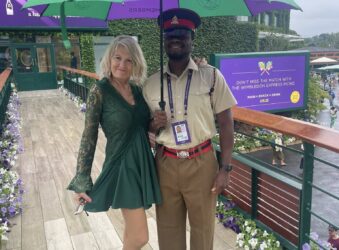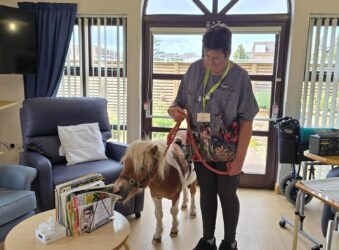Occupational Therapist and Volunteer maintain Hospice Aquarium
Share this story
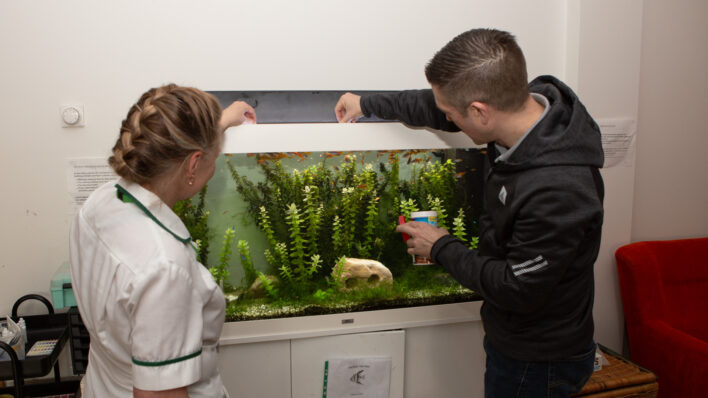
Occupational Therapist, Cat Gregory and her partner, Aaron Venables kindly volunteer to take care of the maintenance and wellbeing of the tropical fish tank in the Inpatient Unit Lounge at the Hospice.
The aquarium at the Hospice has been a feature since the new Hospice opened in 2016. It currently contains one Angelfish (a recommendation from a previous patient who had a white Angelfish at home), five bright blue Cardinal Tetras, several Swordtails and three Siamese Algae Eaters.
Cat reminded us of the importance of the fish tank:
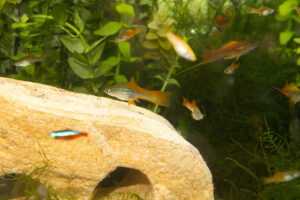
“Patients, their families, visitors and staff all appreciate a few moments of distraction, peace and meditation with the fish. A patient that had been in bed for a number of weeks was hoisted into a chair, and when she saw the fish she took so much joy from seeing them, pointing out the angel fish.”
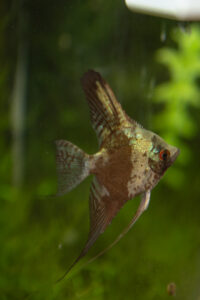
Aaron shared why he likes the fish tank:
“I am a CEO and Chair of Trustee’s for a Charity, so I am busy – the fish give me an opportunity to sit with a coffee and disappear into the fish tank. I have had fish all my life, I find them so peaceful and great for your mental health.”
Aaron explained more about the fish:
“Most of these fish originate from the free flowing Amazon River, so the tank is an artificial environment for them that requires regular maintenance.
When choosing fish there are several considerations to make:
- Choose different fish that swim in the three different layers of the tank – for example the Swordtails swim at the top, the Cardinals in the middle and the Siamese Algae Eaters at the bottom.
- They all have their own likes and dislikes, such as you should only have one Angelfish in a tank like this, as it may get territorial and fight with any other Angelfish.
- However, the Swordtails and Cardinals are shoaling fish and want to be together.
- The plants are essential for consuming waste from the fish and the three Siamese Algae Eaters always like to hide in them.
- Some types of fish live for 4-5 years and others around 10-12 years.
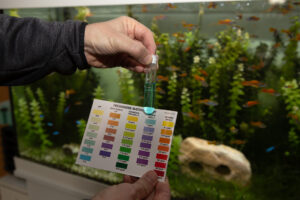
Caring for the fish and aquarium takes time, patience and a certain amount of skill. It took Cat and Aaron three hours to change the water last week and this needs to be done every two weeks. The water also needs to be regularly tested with special chemicals to check the pH and ensure minimum levels of Nitrites or Nitrates, both of which are toxic to the fish.’
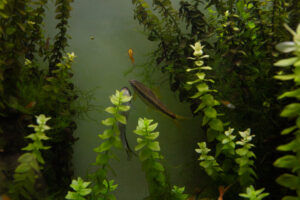
Cat concluded:
“Lots of our visitors to the Inpatient Unit quickly become fond of the fish. Many of the patient’s visitors enjoy getting involved with the feeding of the fish and find helping to keep the glass clean of algae – using the magnetic glass cleaner, therapeutic too.”
Cat and Aaron have two fish tanks at home, which have their own Instagram account: aaca.aquarium and the last post about the aquarium at the Hospice, had over 2,000 views!
If you would like to volunteer for Arthur Rank Hospice Charity, please visit the volunteers opportunities page: https://www.arhc.org.uk/join-us/volunteer-opportunities
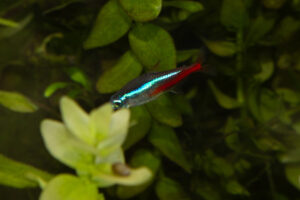
View other stories
-

Living Well Patients at the Hospice relax with Meditation
David Lynch from The Mindful Green Coach, visits the Living Well Service
-

Cambridge Hospice Volunteer supports with pre-loved fashion at Wimbledon Tennis Tournaments in London
Volunteer, Nadia Macari-Brown supports the Charity at one of the most famous sporting events in the world
-

The Alan Hudson Centre receives an unexpected visit!
Volunteer, Anna brings in her pony!
-

Hospice Volunteers recognised during National Volunteers Week 2025
Arthur Rank Hospice Charity says thank you to over 600 volunteers


